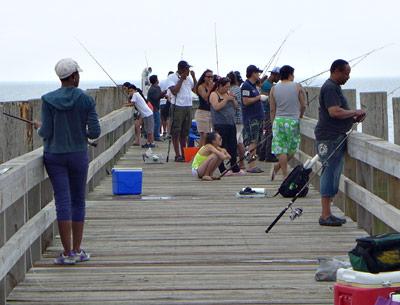The Fort Pond Bay Docks Have Accommodated Many Over the Years

Piers, docks, quays, whatever you choose to call them, Montauk’s Fort Pond Bay has had many over the years. They were built to accommodate commercial fishermen, to test torpedoes, to disembark soldiers, Cunard Line passengers, and more than a few cases of bootlegged booze. One even allowed railroad cars to put to sea.
Whatever its purpose, build it and they will come — the ones with a fishing rod, a bucket, some bait, and a few hours to wile away projecting a fish dinner as an excuse.
Duryea’s Dock has been on the bay’s east side for the better part of a century.
In 1890, Austin Corbin, owner of the Long Island Rail Road, extended its tracks from Bridgehampton to Montauk and conceived, along with the developer Arthur Benson, to make Fort Pond Bay an entry port for passenger ships. A steel pier was built, but the port idea never materialized.
The dock at Rough Rider Landing used to be the New York Ocean Science Laboratory dock, and before that was Fishangri-la, home to charter and party boats.
There was the News Dock, a railroad spur that extended out into the bay so that fish could be loaded directly onto Long Island Rail Road trains.
Another dock was the one that troop ships sidled up to so that soldiers, including Col. Theodore Roosevelt and his Rough Ride volunteers, could disembark after fighting in the Cuban campaign of the Spanish American War.
Old photos show a number of smaller piers that served the needs of a Montauk village located on the bay until the Hurricane of 1938.
Then the Navy arrived and built docks to accommodate the boats that tested torpedoes. When the Navy departed following World War II it left what became known as the “Navy Dock” on the west side of the bay. It deteriorated, but remained a quiet place to fish from for many years. The dock’s tarry remnants were dismantled and a new dock was constructed nearby more than a decade ago as part of the town’s Edward Ecker Park at the end of Navy Road.
This dock had no grand plan. It was simply meant to be a pedestrian pier, a path out onto Fort Pond Bay, a place to fish from. As a fishing spot, the pier has grown in popularity. Porgies, the occasional fluke, striped bass, and bluefish are reeled up, but the truth is — and not to look a gift horse in the mouth — the fishin’ ain’t that great.
The Rough Rider Landing dock to the east is far more productive, especially during the spring squid run, but that dock is private. It’s more productive because the water around it is deeper. Fish — especially those who have reason to hide or lurk in wait for prey — like holes. Even the end of the town pier sits in relatively shallow water. There’s a simple fix.
Larry Cantwell, who will become East Hampton Town supervisor on Jan. 1, is a fisherman. Yes, there will be other issues before him, a budget, airport noise, a plan to hold back the sea, but I’m certain he’ll agree that none is as pressing as seeing to it that the area around the town pier is dredged deep enough to attract squid in time for the spring run. Huck Cantwell knows where his bread is buttered. First things first, and a fish in every pot.
